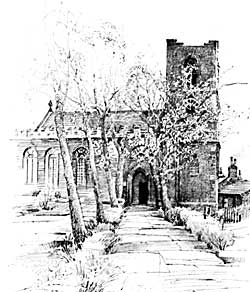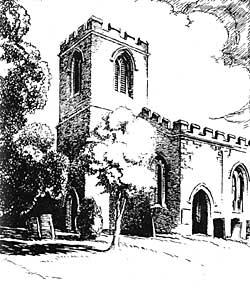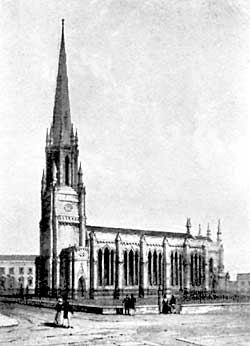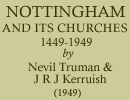Other Churches

The church of St Nicholas.
St. Nicholas' was first built soon after the Conquest, and it is conjectured that it was very like the St. Peter's Church that we know. It carried on its work unmolested until the Civil War. Colonel Hutchinson held Nottingham Castle for Parliament, and was attacked by a force of Royalists from Newark. They established themselves on the top of the tower of St. Nicholas' Church and proceeded to bomb the castle from short range. When they were finally dislodged Colonel Hutchinson felt it imperative to destroy the church as a safeguard against repetition of this action. For a time the homeless congregation was provided for in a loft over St. Peter's chancel. For thirty-five years the site of St. Nicholas' remained vacant until in 1678 a start was made upon a new church. Its design was of Gothic mixed with Classic, as is sometimes found in lesser seventeenth-century churches. The quality of the materials used was poor, and it is a small, undistinguished church with no claims to architectural glory. Yet it is the only church in Nottingham dating from the period of Sir Christopher Wren, and its simple appearance in a green churchyard, withdrawn from the street along a pathway lined by trees, gives an irresistible impression of old-world picturesqueness and charm.
St. Leodegarius, Old Basford, though at first sight seeming to be modern, encloses a fair amount of ancient work, only the north aisle and tower being 1858-60 renewals.
It was consecrated before 1086, Robert de Basford giving it to Catesby Priory in Northamptonshire, which he founded in 1176.
The nave and chancel are Early English; the south aisle is Decorated fourteenth-century work. There are triple lancets at the east end and lancet windows on each side of the choir, dating from about 1225. The nave pillars, not unlike those in Southwell choir, are slender and graceful with one or two interesting heads carved upon them, and there is a quite reasonably good chancel screen in oak.
A rare possession is the Pax of dark red porphyry belonging to the pre-Reformation church and now built into the jamb of the south door. The pax was a devotional aid used at mass. Many of them were engraved or carved with a scriptural scene and they were kissed by the congregation to stimulate devotion and to remind them of the redeeming power of Our Lord—hence the popular name of "kissing stone" by which they are sometimes called.
A stone slab once in the nave, now outside the vestry, commemorates John Clark, a Nonconforming minister intruded into the church living of Cotgrave by the Parliamentarians and ejected in 1662, when the King came into his own again and the Anglican priests who had themselves been ejected by the Protestant ministers were given back their benefices. Clark died in Basford in 1669.
The curious name of St. Leodegarius, which was reduced in common talk to the less complicated St. Ledger, was that of a Bishop of Autun in central France who gave his life to save the town common parlance to the less complicated St. Ledger, was that of a Bishop of Autun in central France who gave his life to save the town of Autun from being sacked in 678, thereby being canonised as a martyr. Dedications to his patronage are extremely rare and it would be interesting to learn why he was chosen to look after the interests of Basford. Was there some link between Catesby Priory and France?

St Peter's church, Radford.
St. Peter's, Radford, was built in 1812 when the ancient church was deliberately pulled down; the chancel was made sixty years larer. Despite these ominous dates, the artist, Mr. William Boswell, has skilfully drawn a most artistic picture here reproduced, making one wish the scene was really as beautiful as he has made it look.
Domesday Book records in 1086 at "Redeford" a church of which there is now no trace and it seems probable that it was repaired and partially rebuilt at the beginning of the thirteenth century. The patrons then were the Prior and Convent of Lenton to whom William Peveril had given "the town and church of Radford". On 12th Kal March, 1224, Walter Gray, Archbishop of York, admitted their nominee to the living in the person of Master Ralf the clerk", Seven hundred and twenty-four years later the present vicar is Mr. Ralph! So does the wheel of history turn full circle.
That vigorous Evangelical leader, the Rev. C. Lea-Wilson, ministered here for thirty-three years until 1913, during which time there was very strong support for foreign missions, and so many Radfordians went out to distant lands to spread the Gospel that a Roll of Honour Board was set up with an impressively long list of their names. No C.M.S. rally was complete without Mr. Lea-Wilson's presence. He kept also in mind the necessity of extending the mission to "Darkest England" by raising the Church of St. Michael and preparing the ground for its becoming a separate parish, thus giving more adequate provision for the teeming population of this part of the city.
A war memorial cross was placed in the churchyard in 1920. The late Georgian or early Victorian vicarage, reconditioned before the last war, is opposite the church in Churchville—a road name redolent of the same epoch.

Holy Trinity church.
Holy Trinity's slender spire was for long a landmark in the heart of the city until it became dangerous and had to be pulled down. At the time this caused regret, but many have now come round to the view that the change is all for the better. The quite graceful octagon with its openwork cresting shows up in greater detail and its proportions can be better appreciated now that the spire (which masked the beauty of the cresting) is no longer present. The tower has something of the same beauty as that in the octagon top of Boston Stump, and I for one would not wish for the return of the spire.
An incumbent who distinguished himself in later life was Dr. Allan Smith who became Dean of St. David's and whose son Martin became Bishop of Hereford and of Rochester. Canon Percy Holbrook, for forty-two years vicar and for eight years after an assistant, fulfilled a ministry which was said to be without parallel in Nottingham and he was greatly loved not only by his own people but by churchmen of all types. It was indeed his ability to appreciate Christians with different views from his own, and his capacity for friendship with fellow clergy of every standard, high, low and broad, which placed him in a unique position. One of the curates (Dr. Stirling) became the missionary Bishop of the Falkland Isles where he had many adventures, living to the ripe age of ninety-five. In Canon Holbrook's time at Holy Trinity there were three other men of distinction —R. C. Billing, later Bishop of Bedford, Henry Wright, Secretary of the C.M.S., and Hinde Smith, of Y.M.C.A. fame.
The contemporary description of the church (in John Bull of October 16th, 1841) would hardly be confirmed to-day. In the flowery language of the period it states: "This building, which has been erected at an expense of £10,000, is a perfect specimen of architectural excellence; the simple and chaste appear to have been studied in its planning; and the grace and beauty of its tall and tapering spire have seldom been surpassed."
The regretted closing of the day schools and the compulsory purchase of the site by the Corporation made possible the building of the very good Parish Hall in Colville Street.
St. Paul's, Hyson Green, built in 1844 and enlarged in 1891, was not commented upon entirely favourably when first opened. The Nottingham Journal made a critique which one must admit to be justified. It said that there was no chancel proper, the altar being relegated to an apsidal recess only twelve feet deep; and the exterior was "marred by a low tower of small dimensions. We understand that it was originally intended to be crowned by a spire, but that design was frustrated through a deficiency of funds." It was hoped that this would soon be remedied, but, while a chancel has been added, the tower still lacks its spire. The architect was H. I. Stevens of Derby. There was a singing gallery at the west end—a position now once again coming into favour as giving greater support musically and freeing the chancels from overcrowding. The silver altar plate was given by Mr. Simpson, formerly Vicar of Christ Church, Newark.
St. Paul's boasts one most remarkable worthy—Mr. Joseph Billyeald, who was for half a century Sunday School Superintendent, and during the same period Day School Manager for forty years, voluntary organist for thirty years, and Churchwarden for twenty-five. The east window commemorates this exceptional record of service.
Other property has been acquired—St. Simon's Hall in Forest Fields with Sunday School and Sunday evening services, and a mission centre in Court Street (behind the Grand Theatre). The parish is almost entirely artisan.
